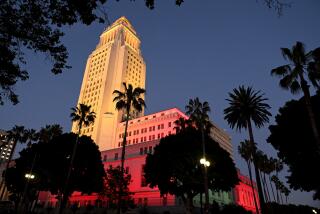Declaring L.A. in decline, commission offers plan for jobs, City Hall reform
Three months after it painted Los Angeles as a metropolis stumbling into decline, the Los Angeles 2020 Commission offered 13 recommendations Wednesday that it said would “put the city on a path to fiscal stability and renew job creation.”
The group of prominent business, labor and civic leaders called on elected officials to enact a wide-ranging series of policy initiatives—increasing the minimum wage, combining giant twin harbors into a single port, altering oversight of the Los Angeles Department of Water and Power and bolstering efforts to promote tourism.
RELATED: The Los Angeles 2020 Commission report
All the actions were necessary, commission members warned, to keep Los Angeles from becoming “a city left behind in the 21st century.”
The panel released its report one day before Mayor Eric Garcetti was scheduled to give the first State of the City address of his administration. Commission Co-Chairman Austin Beutner, who was former Mayor Antonio Villaraigosa’s jobs czar, issued a challenge to elected officials in Los Angeles and beyond.
“The City Council and the mayor ought to give a thumbs up or thumbs down to each one of these,” said Beutner, arguing that if the ideas are not pursued, the commission and the public will be “owed an explanation.”
The commission, proposed last year by City Council President Herb Wesson, called for city pension agencies to make more conservative projections about their investment returns. It also proposed that city elections be moved to coincide with state and federal elections to boost turnout. And it called for the ports of Los Angeles and Long Beach, which compete fiercely for cargo shipments, to join forces to shore up their shrinking market share.
Pension payments, which have been consuming a growing portion of the city budget, were a major part of the commission’s first report, issued in January.
Instead of making specific recommendations on the size of pension benefits, the group called for the creation of a temporary commission for retirement security that would spend four months obtaining “an accurate understanding of the facts” surrounding city retirement costs. Beutner, who once considered running for mayor, said the follow-up commission was necessary because the 2020 panel was presented with conflicting information on pensions.
The 2020 group did specify, however, that it preferred pensions that guaranteed a fixed payment to city retirees over those that fluctuated with the markets.
“In addition to providing employees with a secure retirement,” the commission report said, guaranteed pensions “help the city maintain a stable and experienced workforce.”
Three union leaders served on the commission — one from the Police Protective League, one from the Department of Water and Power’s largest union and one from the building construction trades. Former Secretary of Labor Hilda Solis — a candidate for county supervisor who has long been described by union officials as a “warrior for labor” — also was on the panel.
The commission’s previous report portrayed Los Angeles as a city facing “continued economic decline.” In that document, the group labeled Los Angeles schools a failure and said that a $40-billion 2008 transportation tax would do little to address traffic. Wednesday’s report spent little time on those two issues.
Commission Chair Mickey Kantor, a veteran Los Angeles lawyer and former U.S. Commerce secretary, said the commission had to limit the scope of its recommendations. “We didn’t deal with transportation and traffic. We didn’t deal with education. We didn’t deal with homelessness. We didn’t deal with the environment. We’re 13 people without staff. So we dealt with … what we understood.”
The 2020 Commission joined the national chorus favoring higher pay for low-skilled workers. Noting the high cost of living, the report said the region can “do better than $10 an hour by 2016.” In an interview, Kantor said the higher wage should be imposed countywide at a minimum and predicted that other counties would follow suit, outstripping a state minimum wage that is set to go to $9 an hour this summer and to $10 by 2016.
“If it doesn’t get to $11 for a full-time worker, you don’t get out of poverty,” Kantor said.
A substantial portion of the L.A. 2020 report is devoted to proposals for reconfiguring the bureaucracy to make government more responsive. Beutner called the commission’s recommendation that the city create an independent office of transparency and accountability its single most important proposal.
The new office would have an executive director and staff of about 10 people and function like the Congressional Budget Office in Washington, providing an “honest score card” on how the city spends taxpayer money. Beutner discounted the independence of city offices already charged with tracking spending and performance, such as the Chief Legislative Analyst, who is hired by the City Council, and City Administrative Officer, who reports to both Mayor Eric Garcetti and the 15-member council.
“There is no place for an average Angeleno or, for that matter, someone who works at the L.A. Times, or anything in between, to go for facts,” he said.
Similarly, the 2020 panel recommended the creation of a Los Angeles Utility Rate Commission to oversee the Department of Water and Power, the nation’s largest municipal utility.
DWP commissioners currently volunteer their time and are appointed by the mayor. Under the 2020 Commission’s recommendation, panel members would still be chosen by the mayor but receive full-time salaries and their own staff.
Kantor said this would make commissioners more responsive to customers but former DWP Commissioner Nick Patsaouras called it “just another level of bureaucracy that will take the ratepayers’ money.” The addition of a salary, he said, will make the utility’s leadership more political, not less, with commissions currying favor from officials to keep their jobs.
Other changes offered by the commission could face political opposition. The ports of Los Angeles and Long Beach have their own governing boards, although they have sometimes cooperated, as with the creation of the Alameda Corridor rail line, to speed shipment of goods inland.
Beutner said Southern California could more effectively compete with competitors on the east and west coast if Los Angeles and Long Beach worked together. But Long Beach Mayor Bob Foster questioned the idea of a port merger, saying that in the past, the city of Los Angeles has approved harbor projects that disproportionately affected neighborhoods in his city.
Long Beach sued Los Angeles last year over a $500-million rail yard planned by the BNSF Railway. Long Beach was treated “very poorly by the port and the city of Los Angeles,” Foster said. BNSF Railway was, at the time, a client of Kantor, the 2020 Commission’s co-chair.
“I like Mickey. I consider Mickey a friend. But if he’s going to move down this road, I will have to do what we did on the [rail yard] project and protect Long Beach residents,” Foster said.
Foster said no one from the 2020 Commission had contacted his city about the idea of a merger.
Beutner said his panel relied on data and interviews with people who do business at the ports. “Of course the people of the ports of Long Beach and Los Angeles aren’t going to endorse the idea” of a merger, he added. “They’re going to fight for their turf.”
Another section of the report suggests that Los Angeles can overcome its anemic job creation efforts by focusing on “clusters” of economic activity, such as manufacturing. The city should lead in making clean energy products such as electric buses, the commission members said.
Another cluster could spring up around bioscience and technology — perhaps through a research and development center like the city of New York is creating on Roosevelt Island, with thousands of jobs tied to Cornell University’s planned hub there.
The 2020 proposal also says that uneven and unpredictable city planning regulations have been an impediment to new development. All 35 community plans in the city should be updated by 2020 and then renewed every five years after that, the panelists said. Creating more certainty would free spending by companies and public agencies — leading to the creation of thousands of jobs, the commission contended.
Pressed about whether updating those plans would require more city planners and additional cost, Kantor said much of the improvement could come from will-power. “It’s not magic. It’s intensity. It’s a focus. It’s making it a priority,” said the former Clinton Administration official.
david.zahniser@latimes.comTwitter: @DavidZahniser
@LATimesrainey
More to Read
Sign up for Essential California
The most important California stories and recommendations in your inbox every morning.
You may occasionally receive promotional content from the Los Angeles Times.












